Cooking Diary – Log 8 – 27.05.2012
In Part 1 of the Soybean Saga, I have showed you how to make your own pure, fresh, preservative-free, yummy soy milk. Now let’s turn this gorgeous into a beauty queen, tofu. Tofu is basically soy milk that has been coagulated with the appropriate addition of a harmless chemical.
Tofu is extremely low in calories, saturated fats, and carbohydrates, is free of cholesterol and is an economical source of protein in a vegetarian diet. It is very quick to prepare and easy to use. It is natural, inexpensive and can offer a simple solution for the world’s critical food requirements. 🙂 I am not exaggerating one bit.
Usually, most part of the soy milk I made is being turned into tofu, just a glass or 2 left for drinking. If there is one thing I love more than drinking my nutty, flavorful soy milk warm straight from the pot, it should definitely be the creamy, beany, freshly made silken tofu with a dash of soy sauce. Some complain that tofu is totally flavorless. I agree, totally. Yes, it is bland, but that is its unique beauty. Can you find other ingredients that can be as versatile as tofu? Because of its blandness, it absorbs, blends in, and complements very, very well others ingredients’ tastes. Some are born with a golden shiny hair like a sun. Some are born as hazelnut brunette. Of course the shiny things catch people attentions immediately, but think again, aren’t they both as beautiful?
In this post, I will describe the way of making tofu in my kitchen, plus almost all you need to know about homemade tofu. 3 best things about my method would be:
1) It is easy to follow with detailed instruction and pictures at every step, as in every post in my blog. I have tested making tofu with many different methods without many successes. This is the most sure-fire one in my kitchen.
2) Firstly out of this method, you can have silken tofu to enjoy, either as Kinugoshi (Japanese for silken tofu) with a dash of bonito flakes, soy sauce or ponzu sauce, freshly grated ginger, finely chopped cucumber, chopped scallion as a savory dish; or as sweet dessert like Tau Fu Fa (Chinese for soymilk custard in ginger syrup sauce) and Tàu Hũ (Vietnamese for the same thing).
3) Secondly out of this method, you can enjoy normal and firm tofu as sold in the supermarket, but with premium quality, if you follow with next steps. The control is totally in your hands.
Excited yet? 🙂 Once you have your soy milk cooked and still boiling hot, you are about 10 minutes from making hot, delicious and organic tofu. I know that the following will be very long to absorb, but I did try my best to make everything as clear as possible, so keep up with me, will you? 🙂
——————————————-
Ingredients
(Make 2 liters silken tofu – 800g soft tofu – 500g firm tofu)
- 2 liters of fresh soymilk made from the recipe here (Caution: store-bought soymilk won’t do!)
- 3g Gypsum – 2.8 g to be very precise in case you have a super scale. If you are a perfect little “freak” like me or you want perfect silken tofu, you will want to subtract a tiny bit of a water drop size out of the total 3g in order to achieve 2.8 g of gypsum, like this size.
- Don’t underestimate the 0.2g of gypsum, it will cause a huge difference in your tofu texture, for instance, use 0.2g more of gypsum will almost reach the setting limit of silken tofu, make it more fragile and easy to be broken down. (see Notes below for more information about tofu coagulants)
Recommended Utensils
- 1 pots of 4-liter capacity
- 1 pots of 3-liter capacity
- A heatproof spatula
- A 50x50cm very fine and strong cheese cloth, or cotton muslin, or other porous fabric
- A tofu mold (mine is a 22x11x5cm wooden mold, see note below to make yours)
- Heavy-weighed objects such as books, rocks (Mine is a 7kg homemade wine container)
- Optional – A thermometer (because tofu best coagulated at 85 degree Celsius, in case you want to check)
——————————————-
Some Notes before starting
Note on making Tofu
1) Here is a little warning about tofu homemaking that I think you should aware of before proceeding. For some reasons, maybe it is the uncertainties in the home kitchen environment and the lack of quality measurement and management, (wow, I am talking big, baby! LOL) My tofu has come out a bit different from each other from time to time. Sometimes the tofu was a bit too firm and lost some of its volume, other times it was soft and watery. Sometimes it was a bit grainier. Sometimes the curds were smooth and creamy. Some other times, unfortunately, the tofu didn’t seem to stick together, like at all.
It is, of course, sounds very risky, but whatever the outcome turned out, I always eat them all up because they are so delicious. So, don’t be afraid of giving homemade tofu a try. It will still totally be worth it, one way or another, and with some practices and experiments, may we find the golden rule for our own kitchens.
2) Making Tofu requires strength, carefulness, speed, patience, and passion. Strength to pick up a big pot of soy milk and do all the pouring and pressing work. Carefulness to not burn yourself into process of handling boiling hot milk or tofu. Speed to process the tofu as fast as possible. Patience to wait for the silken tofu to set without peaking for 20 minutes; to wait for water to be pressed out of the tofu mold. And passion to try again if couple of first times does not turn out right. Do you have all the qualities? 🙂
——————————————-
Note on coagulants
Time to get scientific! There are a lot of different coagulants for making tofu. Among them, the 5 main sources that usually use at home making level are:
1) Gypsum – (calcium sulfate) this is the tofu coagulant that is commonly used in China and Vietnam (currently). Use the food-grade gypsum, not the kind used in construction business or as cooling medicine in Chinese Oriental Pharmacies. 🙂 It is calcium rich, naturally occurring mineral that coagulates soy milk for tofu, plus, adding more calcium to your diet. Gypsum may be found at the Chinese grocery stores in your areas.
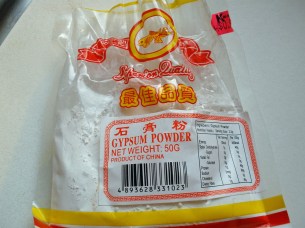
Gypsum powder (source: bakingquinn.blogspot.com)
I must say that making tofu out of this coagulant, quite easy. But when it comes to silken tofu, Gypsum has a quite narrow window of success. Too little and the soybean milk just remains a thick, slurry milkshake. Too much and the soy milk curdles immediately and your only choice is to drain the water and press it in a mold to make normal tofu. So it is fatally important that you measure your beans and coagulant very, very precisely. I highly recommend using weight measurement rather than using teaspoon or cup. One tofu expert have taught me their ratio, 1 kg good dried soy bean : 17g Gypsum. And that’s what I share with you guys today. 🙂
Some claim that consuming Gypsum will cause kidney stones. I afraid I have to break this myth once and for all. 🙂 Everyday, we adult (age 19 to 50) need about 1000mg intake of calcium. Infants and toddlers need less, around 200mg to 700mg while children, teenagers and seniors need more, around 1200-1300mg. Each liter of silken tofu (approximately 4 cups) or 250g of extra firm tofu or 450g of medium tofu made by gypsum contain around 1000mg (1g) of calcium. It means we have to consume each of all these above, in order to reach out body need for the whole day, not to mention triple, even quadruple or more of that, for a long, long time like each and every day for many years in order to have those funky jewels in your kidneys. So, small chance it is, isn’t it? No more unreasonable fear, OK?
2) Epsom Salt – (magnesium sulfate) is recommended for first time tofu makers since they are cheap and very available in the USA, Canada and Europe, at most drug stores. More importantly, the magnesium based coagulants are easier to use because it has power to cause the separation of soy milk into curds and whey to happen more quickly, and more definitively than with a calcium based coagulant.

Epsom salt (source: al.godsdirectcontact.org.tw)
For this recipe, if you wish to use Epsom Salt, exchange 3g of Gypsum by 1tsp. Epsom Salt, diluted in 2 tbsp. of hot water or cool soy milk.
3) Nigari – (magnesium chloride) is the tofu coagulant that is most commonly used in Japan. However, the nigari sold as a health supplement (which recently claimed to have weight loss effect) doesn’t seem to have the same coagulating power as the nigari sold specifically for making tofu. So to make tofu, buy nigari from tofu and soy milk making oriented sources.

Nigari (source: publicradio.org)
For this recipe, if you wish to use Nigari, exchange 3g of Gypsum by 1 tsp. of Nigari, diluted in 2 tbsp. of hot water or cool soy milk.
4) Lemon juice or vinegar – the acid will also coagulate the tofu. The final products made with lemon juice or vinegar will yield a bit of sour, interesting taste. In the past, Vietnamese tofu manufacturers used a mixture to coagulating tofu, not pure lemon juice or vinegar, but the sour whey extracted from the previous batches. You did not get it, do you? Me too. Sometimes I lost it. OK, let me try again.
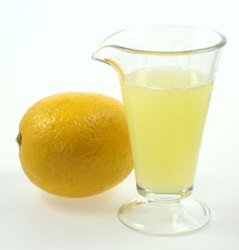
Lemon Juice (source: health-tips4.blogspot.com)
How to make the tradition Vietnamese “sour water” for tofu? Firstly, they will do a batch of tofu by pure vinegar or lemon juice. After coagulating soymilk, they will have a clear soy curds and soy whey – yellowish water that have milder but still sour taste. This soy whey will be the coagulant for this next batch of tofu. How’s that now? Using “sour water” claims to result in more flavorful and tender, and richer tofu, but less in volume comparing with other coagulants, meaning less economic. Therefore, less and less manufacturers in Vietnam use “sour water” to make tofu, they change to gypsum. 😦
For this recipe, if you wish to use Lemon juice or vinegar, exchange 3g of Gypsum by juice from one lime (about 60ml) or 2 tbsp. of distilled vinegar, diluted in 1/8 cup of hot water. However, do not expect silken tofu out of this coagulant, not possible.
5) GDL – (short for Glucono Delta Lactone) GDL is a naturally-occurring food additive used as a sequestrant, an acidifier, or a curing, pickling, or leavening agent. Pure GDL is usually in form of white odorless crystalline powder. Natural GDL is commonly found in honey, fruit juices, and wine. It is now commonly used in making commercial tofu. GDL is usually used for making silken tofu because it is easier to use, more tolerable when it comes to texture, but not taste. If you add too much GDL, the final result will be firmer but it tastes quite sour, like spoiled milk. GDL also gives a smoother, more jelly like texture, while Gypsum gives a softer, more custard-like texture.

GDL (source: wendyinkk.blogspot.com)
For this recipe, if you wish to use GDL, exchange 3g of Gypsum by 3g or ¾ tsp. of GDL, diluted in 2 tbsp. of water.
The reason I choose Gypsum to make mine tofu is because:
1) It results in the plainest taste tofu, which can easily complement other ingredients in cooking.
2) It can be use to make both silken tofu and normal tofu in the same batch. Hence, more choices for me.
3) I could not get a hand to other coagulants like Nigari or Epsom salt, or GDL. I am a very honest person. I did not have many experiences working with those two, either.
4) The results I made with lemon juice or vinegar is too firm for my taste and the final product yields were much lower than using gypsum. Of course I want to be economic when it comes to cooking.
UPDATED 21/01/2013: I have heard some recent feedback from Sheila of “The not so straight forward life of a dental student” about using epsom salt to make silken tofu. Her experience with it was not satisfying. The problem that she encountered was that “the tofu was like vomit in the bowl“. But I think I kinda know the problem , thanks to many own attempt, and failure of course in the past. To make long story short, this curdling problem happens when the amount of coagulant is too much for the amount of soy milk. And this can be caused by 2 things:
1) Your soymilk is not thick enough. Well, I must say, this is a very vague topic. This really depends on the type of beans you use, the techniques you use to milk and cook them. If this problem happens to you, I suggest that next time, you try to blend the beans more finely, squeeze them a little harder to get all those precious juice out. Or try using a little more beans for the same amount of water, maybe add about 50g more. and finally, just to make sure, cook them a little longer to evaporate more water from the milk, this might yield a little less tofu, but well, it is for the best.
2) The coagulant is too powerful for that amount and thickness of soy milk. This again, is kinda uncertain for amateur for us. As I said above, Epsom or other coagulants (that I have not have the chance to experiments) has quite powerful setting ability comparing to gypsum (that I tried), I recommend you to experiment with this matter, by reducing the amount of coagulant little by little, to see how it going. Next time, together with working on your milking techniques to improve the soymilk thickness, how about trying a tsp. (or stated in the recipe) of coagulants minus just a little pinch? ![]()
Ah, one more important thing is to make sure your blend the coagulant with the hot soymilk as fast as you can. The process should be done in about 5-7 second.
I know, it is frustrating and time consuming to make tofu, especially silken tofu. And it is event more disappointing when all that hard work did not turn out as well as you expected. But it is alright, we are all enthusiasts who are willing to learn, not pros who has to do it perfectly all the time. In Vietnamese, we have a saying “Trăm hay không bằng tay quen”, meaning “you will definitely get better at things when you try to perfect it again and again”. And I think this is specifically true in cooking and baking. Of course there are ones that are blessed with exceptional taste buds or skillful hands, but we can all get there if we want it and try hard enough. 🙂
I wish you all the world’s luck, passion and patience with tofu making. Please do come back and give comment, feedback on the recipe, I am more than willing to help and learn. 😀
——————————————-
Note on Tofu mold
I am now having a 22x11x5cm wooden semi-pro tofu mold to serve my obsession at making the perfect tofu. 😛 Here is a picture of it:
It works perfectly in making tofu from 1 to 2 liter of soymilk in my recipe; final result is about maximum 500g of firm tofu each batch.
Here is some ways to make yourself a tofu mold, aside from buying it if you can:
1) If you, or your fathers, brothers, husbands, boyfriends, (I just assume, no sexism here, LOL) or anyone are good carpenters, you can make it yourself, following this instruction. Build a wooden frame from finished 1.5cm (3/4-inch) thick lumber. The open frame can be square of approximately 15x15cm (6-inches by 6-inches) or rectangular of 22x11cm (8.5-inches by 4.5-inches) and have a height of 5cm (2-inches). Build 2 pressing boards (removable) from the same lumber. The dimensions of the top should be 0.3 cm (1/7-inch), on every side, smaller than the interior dimensions of the frame. Tap 2 lumber sticks across the bottom of the frame to hold the bottom board. The top board has a handle for easily removing when the tofu is done.
2) How to make your own tofu mold using 2 heavy loaf pans:
http://ieatfood.net/2009/05/09/how-to-make-a-heavy-duty-steel-tofu-press/
3) Using 2 heavy-duty plastic boxes of the same size, Drill several small holes at the bottom of one box. (I used to do this all the time before buying the current one)
4) Using a round strainer as the mold. Like in this picture. Of course you will not have a square pieces of tofu out of this kind of improvising mold, but it still make decent tofu.

Improvising Tofu Mold (source: http://www.justhungry.com)
Whatever technique you choose, just make sure you have a lid, or a board, or a dish that fit inside the pan, strainer, or box dimension, act like the top board of the tofu mold.
——————————————-
Instructions
Again, follow this recipe to make your own fresh soy milk. Then continue with these steps.
Step 1: Save ½ cup of cool soymilk aside for making coagulant. Reheat the rest of your fresh homemade soy milk at medium heat to a boil, again. Stir every 1-minute to prevent burning at the bottom.
Step 2: While the soy milk is being reheated on the stove. Time to make your coagulant mixture. Dilute 2.8g of gypsum (remember the tiny amount mentioned above) in ½ cup of cool soy milk, stir very well to combine.
Step 3: When the soy milk is boiling, turn off the heat, and let it sit on the stove for 5 minutes to cool it down to about 85 degree Celsius. This is important because the Gypsum require high temperature to activate the coagulating power.
Now, pour the coagulant mixture into the other prepared big pot, NOT the soy milk pot. Shake the pot in circular motion to have the coagulant evenly coat the pot side.
Step 4: Now this is a very important step of the tofu making. You have to arrange the coagulant coated pot onto a chair or lower surface than your kitchen counter. Make sure that it stay very sturdy on that surface because we gonna do some serious pouring. 🙂 I use a chair pillow to settle the surface. Look in the series below.
Prepare a heatproof spatula near by the chair where you can easily find and reach. And also, set up this chair-pot system somewhere in the house, near the kitchen, where it can stay very still and unharmed without conflicting with your daily chores for the next 20 minutes.
Step 5: Now that your soymilk is simmering (it is super hot, so be careful! But being able to work FAST with tofu is necessary), with the kitchen mittens on, CAREFULLY get it out of the stove. Now you are standing on the floor, with your body facing the coagulant coated pot. From 40cm above the chair surface, you want to pour the hot soy milk into the pot very fast, and very forcefully. (But again, be careful; don’t let the hot liquid splash on you) It will bubble up quite lots; you are doing the right thing! Get closer to the coagulant pot at the end of the process, like shown in this series. (I made this series in Microsoft Word, can you believe it? LOL)
Now, grasp the spatula, give the soymilk-coagulant coated pot 2 or 3 quick but strong stirs, make sure the spatula reach to the bottom of the pot. The reason for these quick stirs is to make sure the coagulant/gypsum is contributed evenly in the soy milk.
Step 6: Now immediately close the pot lit, lined with a dry clean kitchen towel like shown in the picture.
This is to absorb the steam evaporated from the hot soy milk in order to prevent them from liquidized and drop back into the coagulating tofu mixture, and annoying it. You must remember that the soy-tofu mixture in this pot right now is really, really fragile. Treat it like a thousand-of-euro Swan made by Swarovski crystal. Don’t touch it, don’t move it, don’t do anything risk disturbing the coagulation, and no peaking, please! Patiently waiting for 20 minutes will be fully rewarded. I promised. 🙂
Step 7: While waiting for the silken tofu to set, prepare the tofu mold near the kitchen sink. Make sure that the inner board is in if you are using a wooden mold like me. Line up your mold with prepared cheesecloth.
Step 8: 20 minutes are up! Aren’t you nervous? Excited? Worried? Open up the lid, now please. 🙂 Here is my silken tofu. YAY! We did it!
See how it is beautifully set? WOW! The first time I made this silken tofu to happen, I was so happy, I jumped around the apartment, closed the lid, opened it; touch the tofu, and repeated the whole cheering process all over for like 5 times. DON’T be like me, unless your goal is to make silken tofu only. If you set eyes on the medium/firm tofu block, we have not finished yet!
Tofu curds stick to each other, ONLY when they are still hot, very hot. Therefore, you have to work fast, really fast, to transfer those beauties into the mold for instant pressing.
Step 9: Put the mold into the clean, non-watery sink. Use a spoon with thin edge (I cut of half of a soda can into a scoop form, the edge needs to be sharp and thin, in order to easily cut into the silken tofu without shattering it), to scoop the hot silken tofu out of the pot, into the mold. Work fast!
You can eat this right now, with a dash of soy sauce, or the regular like I usually enjoy, with ginger brown sugar syrup (recipe after the instruction). Eating this silken tofu is like tasting cloud in your mouth, literally. It is so smooth, so soft, and so fragile that it just flows into your throat like a wave of air. 🙂
Scoop it out into the tofu mold, like this.
Step 10: After scooping all the silken tofu into the mold, you want to use a knife to run some line across these curds or grasp 4 corners of the cheesecloth, lift it up and shake it a little, in order to give ways to the pitiful soy whey (the yellowish water that splits away from the curds when they are broken) that trapped in the layers of curds; in order to achieve a baby-butt smooth, non-holey texture in your final tofu.
Step 11: Now cover the surface of the curd with the cheesecloth, like this. Do this very neatly! We don’t want an uneven or rocky tofu block, do we? And again, work as fast as you can to keep the curds very hot.
Step 12: Put the top board on. Press down very hard, but use even forces among every corner of the top board, to get as much soy whey out as you can. This is also to make sure that the curds are well introduced to each other.
Step 13: Use heavy objects like books, or rocks to make the pressing system for the tofu. I used my enormous wine bottle, like this. You want heavy objects, about 7 to 10kg in total. Make sure that the system can stand on its own in the kitchen sink, and distribute an even and heavy pressure on the top board.
Step 14: Now all you have to do is wait. Yes, I know, it is frustrating, isn’t it? Keep up with me, OK? The heavy pressure applied on the top board will stick the curds together, and squeeze water out of the tofu curd to make them firmer. You have total control on how you want your tofu to come out.
- Soft tofu for miso soup: wait 25 minutes.
- Medium tofu for frying: wait 30 minutes.
- Firm tofu for salad: wait 35 minutes.
It is the timer in my kitchen, due to the weight of my wine containing bottle. If you have lighter objects (no less than 6kg), you might want to wait about 5 minutes longer. If you have heavier objects, you can proceed with the next step about 3 minutes sooner. Check by peeling out the cheesecloth and press, if the tofu is sticking to the cloth, it is not done.
Step 15: After the desired waiting time, you are now granted to open the cheesecloth surface. YAY! Here is my tofu, still in the mold, though. Make cuts in the tofu to the smaller desired size, because it would be risky to get a full size tofu block out of the mold. I cut mine into 4 rectangles.
Now what you want to do is to get the mold out of the sink, fill the sink with very cold water. Flip the tofu out of the mold.
Now carefully peel the cloth out of our tofu.
Today I want to make medium tofu. But I got hooked up with a new, very interesting TV series (Shameless – US edition, you might know?) So I kind of went a bit overboard with the time, 33 minutes to be exact, so my tofu is a bit to the firm side, but no biggies, still great for us. 🙂 There you go, homemade tofu! La la la!
Mine weighed at 569g of firm tofu. It is almost triple the amount of soybean you used, right? 🙂 Break my record, again. Last time I did this; 325g firm tofu out of 150g soybeans. YAY! Here is a picture of one time I made both soft and firm tofu. Look at their size and see the differences. Can you believe they are made from the same amount of soybeans? 🙂
——————————————-
Traditional Chinese Tau Fu Fa or Vietnamese Tàu Hũ
Silken Tofu Dessert in Ginger syrup
Ginger syrup
- 1/4 cup raw brown sugar
- 2 pandan leaves, cleaned and knotted (optional, this is how we did originally in Vietnam, but I cannot find this ingredient here in Finland, also)
- Thumb-size ginger piece, peeled, sliced at 0.5cm wide, and smashed with the side of a knife
- 1/3 cup water (Stir to dissolve with the sugar, taste, and then add more to your taste)
Bring everything to boil in a saucepan.
When the sugar is melted, let the sauce simmer for 5 more minutes.
Remove from heat and cover to let the pandan leaves and ginger infuse the sugar syrup, for 20 minutes. (Hehe, have you noticed the reflection on the ladle of me holding the camera? LOL)
Coconut Milk sauce (Vietnamese Style)
- 100ml coconut milk
- 1 tsp. corn starch
- 1 tbsp. water
Boil coconut milk in a sauce pan. Dissolve cornstarch in water, pour into the boiling coconut milk while constantly stirring until thicken, custard-like. Let cool.
How to serve
Use a thin-edged spoon to scoop the freshly made, hot silken tofu as thin layers out in the serving bowls.Here I want to show you the texture of my silken tofu. 🙂
Gently pour the warm ginger sauce over the tofu, follow by a spoonful or two of coconut thicken sauce for a Vietnamese flavor.
And Enjoy!
——————————————-
BONUS 1 – Making Silken tofu Dessert by Gelatin or Agar-agar Powder
(Thanks to RotinRice and Quinn’s Baking Diary)
I normally don’t do bonuses. But yeah, I have been totally ignoring you, my dear readers, and this blog for the past 3 days, and it is weekend. I feel very sorry. So let me make it up to you, OK? 😉
You want a sure-fire silken tofu dessert? You just want to enjoy it chilled? You don’t want to mess tofu up with those tricky coagulants? So here it is, a chilled silken tofu dessert recipe. No complicated cooking or gypsum needed! YAY!

Silken Tofu made by Gelatin powder (source: http://bakingquinn.blogspot.fi)
Ingredients
- 300ml soy milk (Store-bought and fresh homemade is both OK)
- 1 tsp. gelatin powder or ½ tsp. agar-agar powder
Instructions
With Gelatin – Dissolve the gelatin powder by sprinkling it over 1 tbsp. of water. Set it aside to spring for 5 minutes. Place the soy milk in a pot/ or microwave and reheat gently. When it is about hot to touch, take it off the heat source and pour in the gelatin paste. Whisk it to dissolve for a minute, make sure the gelatin melted and contributed well in the liquid.
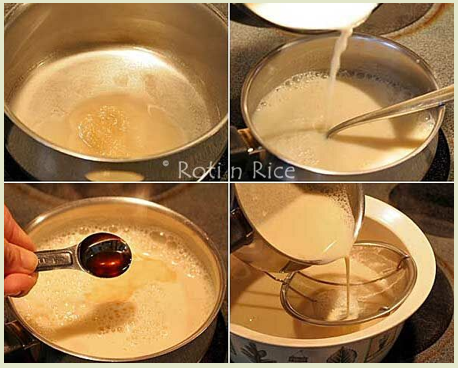
Making Silken Tofu by Agar or Gelatin powder (source: http://www.rotinrice.com)
With Agar Powder – Divide soy milk into two portions (100-200ml). Pour one portion 200ml into a saucepan and heat it up over low heat, stir to prevent burning. Dissolve agar-agar powder in 100ml portion and mix well. When soymilk in the saucepan turns slightly hot, gently pour in the soy milk and agar-agar mixture into the saucepan, stir to mix well. Stir from time to time, cook for about 5 minutes over low heat with constant stirring. Turn off heat when you see bubbles on top but not wait until it boil.
Pour the hot soy milk mixture into a large bowl, containers or ramekins. Skim off the bubbles on top. Cool it down to room temperature, skim off a thin layer of tofu curd on top, if there is and chill it overnight in the fridge, cover tightly with a plastic cling wrap.
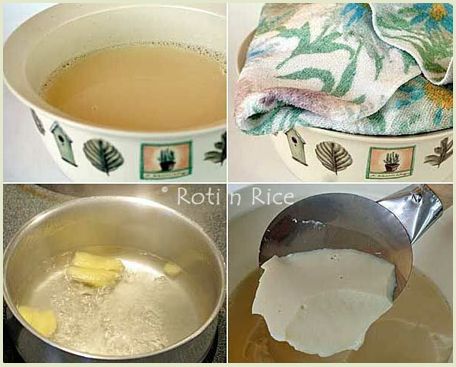
Making Silken Tofu by Agar or Gelatin powder (source: http://www.rotinrice.com)
Next morning, scoop it out in serving bowls as thin layers, serve with chilled until very cold Ginger syrup (and coconut thicken sauce, if you prefer Vietnamese style). Remember, DO NOT serve with hot syrup, or the silken tofu will melt.
——————————————-
BONUS 2 – Silken egg tofu
Thanks to Table for 2 and more
Another bribe for my faithful readers who keep up with my usual long post till now. J Here is another easy, no hassle silken tofu recipe! Wonderful for savory dishes, no gypsum needed, just eggs and you are good to go. You might know this little tube here, it is egg tofu package sold commercially.

Commercial Egg Tofu (source: ingredients.noobcook.com)
Ingredients
- 500ml Soya Milk (Store-bought is fine)
- 6 eggs
- 1/4 tsp. salt
- 1 tsp. of corn flour mixed with 1 tbsp. water
Instructions
Mix eggs and soy milk and corn flour mixture evenly. Mix in salt and sieve to remove any bubbles and egg white strings. Pour mixture into a pan or a heatproof container that can fit in one of your big cooking pots. Cover the container with plastic wrap or lid. It is best if you have a glass, or ramekin, or heatproof silicon pans. Metal pan will heat up very quickly, which leads to high chance of curdle up your egg tofu.
Bring water in steamer to boil and then switch to low heat and place the pan/container with mixture in. Steam for 15 – 20 minutes. Remember, at low heat!

Egg Tofu Making (source: http://wendyinkk.blogspot.fi)
Set aside to cool and keep in refrigerator overnight. Remove and cut desired size pieces. Now, eat it, fry it, enjoy!

Egg Tofu (source: http://wendyinkk.blogspot.fi)
Egg tofu has a milder, less beany flavor than normal tofu. Its texture is silky-smooth and slightly reminiscent of eggs. Because of its delicate texture, cooking egg tofu must be done with a light hand. 🙂
——————————————-
Now to conclude this never-seem-to-end post, I just want to add one more thing: how to store your homemade tofu. Once your final product is done, keep it the unopened tub in the refrigerator until ready to use, it will be OK for about 2 days. There is a better alternative: to store it in a sealed glass or plastic container under a few inches of water and some pinches of salt. It will last for about 5 days with daily change the water in the container.
Trust me when I say that you’d better consuming homemade tofu very soon after it is made. If you don’t, well, let’s just say it’s probably one of the worst-smelling items you’ll ever pull out of your refrigerator. 😉
Freezing tofu is also an option and only thaws the needed amount for each use. Some fork intentionally freeze tofu because once it’s thawed, it has a more porous texture, resemble to texture of a fish or chicken fillet.
Here are more tips I found very interesting.
————————————————
OK, I should stop now. 🙂 Brain gets frozen again, LOL.
If you have any questions, comments or recommendations concerning this matter, please feel very free to contribute. I would really appreciate that and try to respond to my furthest knowledge limit. 🙂
Have a very nice weekend, everyone.
Rose,



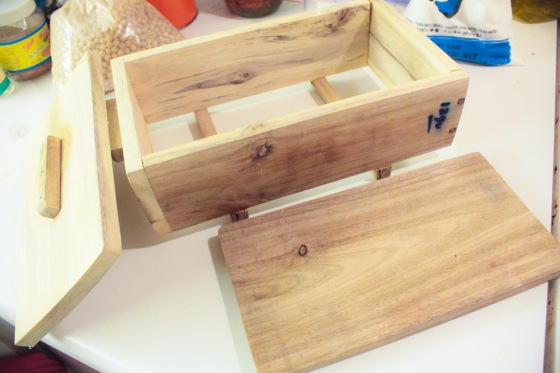

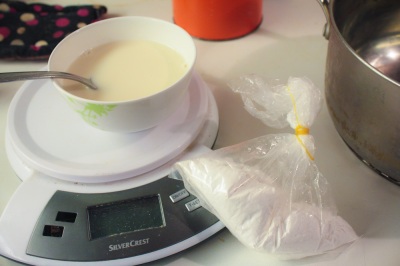




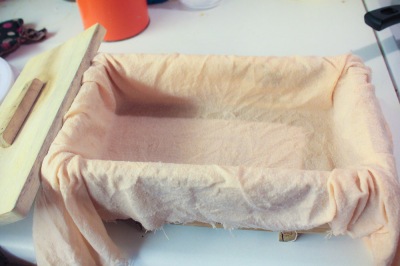

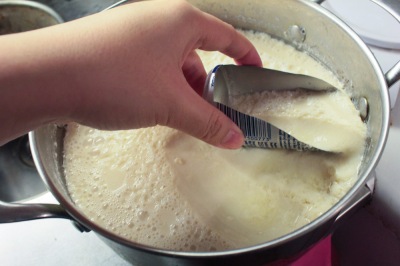
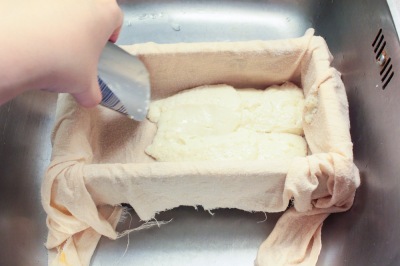
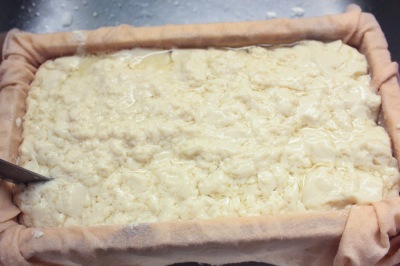
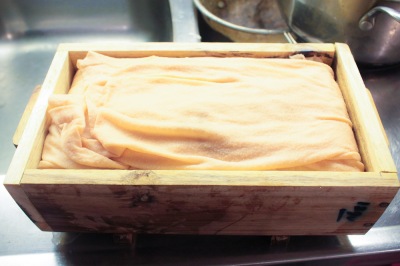




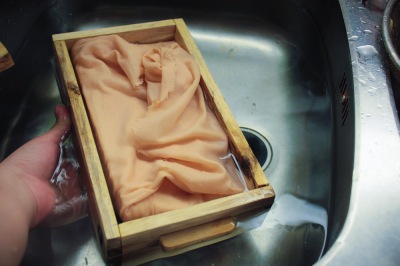




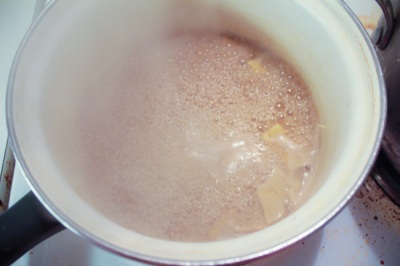

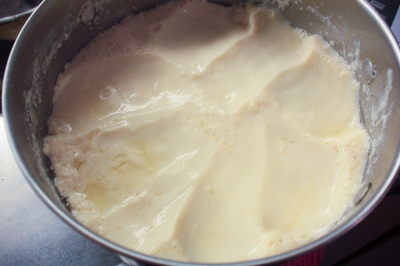
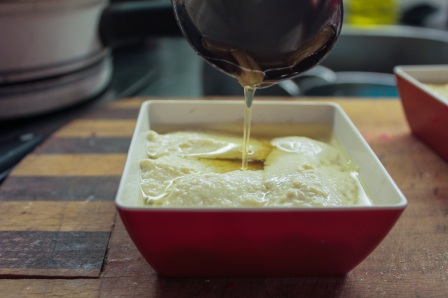

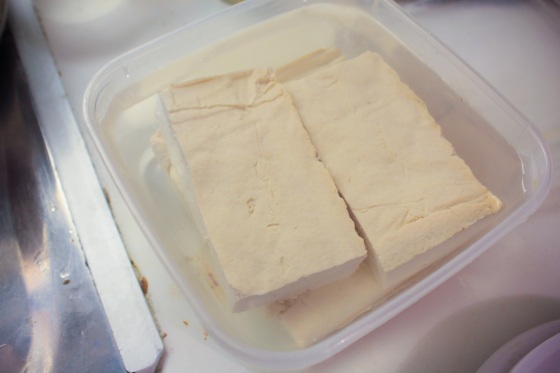
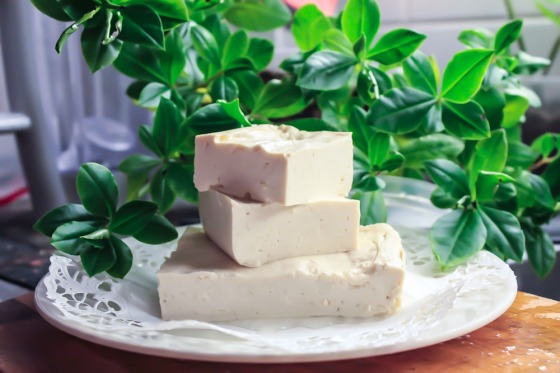
27th August 2019
My family has always cooked taufu with different kind of dishes. Since living in Uk though is easy to buy from chinese store, but i like to learn how to make it as i love my home cooked foods.
Then i began to search and found yours is the best description. Is clear explaination easy to understand has picture with every of the instruction. You also share you your thought for others who do not know some ingredients that they have not known, from there you explain very clearly.
I then give a try with patience , with your pictures each of the instructions i have followed it and i have it sucessfully make the tau fu that I have always wanted to learn. At one point i have got wrong because i have added in too much water and not enought soya milk for the gysam to coagulated I then realised i have make this mistake.
Three years on i still make the tau fu and even up to date . I love to eat tau fu fa with ginger brown sugar syrup, which i will be following your recipe in your post.
I have booked marked them of all your recipes and even write down to bring to the kitchen whenever, i want to make tau fu .
I just wonder this author is he or she and would be interesting to know which country he or she lives. Would love to see author picture, love to know this is the person who has great talent of teaching to others who wants to learn cooking.
At some point soon i am returning to Malaysia for good but i will still want to make the tau fu but do not know wil it be easy to buy gysum from the store.
I want to thanks the author of its great talent and throught geniune teaching
LikeLike
Hi Miss Tan, it really warms my heart reading your lovely lines and that my recipe is giving you more joy in the kitchen, thanks a lot for your kind words.
Since the post, I finished my Bachelor degree in Finland, earned an MBA in Berlin, and now I am a Management Consultant and living in South Germany. Let’s keep in touch, if you want to write me, feel free to reach out at rose.nhungkieu@gmail.com.
Many thanks again for the comment, it really made my day. Hope you and your family are healthy and happy, wherever you are, Miss Tan.
Rose.
LikeLike
Hi, how is it possible that I get only around 280g of tofu from 200g dried soybeans and 2.8g of gypsum :(? And when it coagulates it behaves similar as with vinegar (yellowish water at the surface and tofu pieces below). And I havent’t got silken tofu phase at all. Do you have any idea of what could I do wrong? I had around 220g of okara left and 2 liters of soy milk before boiling.
LikeLike
Hi Joanna,
I must say that unfortunately It is entirely possible that you made only that much tofu with the same soybeans and coagulator as I did. Why would that be? Please experiment with grinding the soaked beans finer than you are now or increasing the amount of beans or different type of soybeans. Based on my experience, if with the same amount of gypsum but your milk behaves like described, it is probably too thin…
Hope it helps and keep me updated how it turns out.
Rose.
LikeLike
Hi Rose
I just yesterday was talking to a friend about tofu and I decided to look into making my own. I am vegetarian and like to eat tofu almost everyday.
Luckily I came across your FANTASTIC! Soybean Saga.
I want to do this properly and be successfull and I know that I will be able to with all your information!
So I want to get a Tofu Press – I looked online and saw some nice wooden Japanese presses – where did you get yours?
Once I get started I will let you know how I get on!
Thank you so much for sharing your knowledge with everyone and for providing such detailed instructions!
If you ever need any help with making bread or patisserie please let me know if I can help you – I work professionally in this area and I trained and worked with many of the best bakers in France which means some of the best in the world!
Bye
Rossa
LikeLike
Hi Rossa (does it also mean “Rose”? :D)
Thank you sooo much for your kind words, really appreciate it. I believe strongly in sharing my experience so that others could follow courses, make progress in shorter time and enhance it further.
I bought my tofu press in Bến Thành Market here in Vietnam, not an option for you I guess… But I also did some search on Amazon and found those Japanese molds to be quite similar (with about 6x the cost of what I pay here, yikes!). Just make sure you buy the one with invertible bottom for better release once done.
And wow, I’m so impressed by your introduction and thank you for your kind offer. I’m very much into boulangerie (more than patisserie), now I’m exploring sourdough and yeast water baking at home level. It’s tough figuring it out all alone here in Vietnam, where artisan bread is not much of a popular topic, people still favor easy-breezy commercial yeast and soft breads. not to mention my family is quite traditional and the society doesn’t appreciate the arts of making good bread or the vocation… I have been obsessed with bread for almost 7 years now and keen on explore how to do it more professionally. It would be eye-opening for me if only I could have some mentor/master in the field to guide me through this tough journey.
Anyways, now to think about it, if you are not too fond to explore tofu as fast as you can, I have a friend who will travel to France (Paris) early September, I could gift you a mold. 😀 Or later in October, I will be in Germany for my MBA. I’m helping out a traditional tofu maker in my city right now, hopeful to learn techniques from the best. Let me know if you want to.
Glad to have you visit my site, it’s truly an honor.
Rose.
LikeLike
Hi Rose
Sorry I am so slow to respond – I seem to be too busy all the time!
I bought a nice Japanese wooden tofu mould but have not used it yet as I have had no time to try out tofu. I am just refreshing myself now as I want to make tofu in the next few weeks – I have 5 kilo Organic soya beans ready. I just need to buy some nigari.
So of course I am going to reread your fantastic blog before I start!!
Bread – email me silverbluesnow@gmail.com with any questions. I dedicated years of my life to making sourdough bread so I can help you!
Great that you are working with a tofu maker in Vietnam – are you going to do a blog post on it?
Nice to talk with you!
Rossa
LikeLike
Hi,
I know you might not be reading comments I 2016 but I will give it a go.
I made tofu twice, first first time with Nigari and second time with vinegar. Both times soya milk curdles were really thin, I managed to make tofu but it was not like on the pictures or videos I watched when other people made tofu. Could you tell me what I might be doing wrong? Thanks!
LikeLike
Hi Katolina, thanks for stopping by even if it’s 2016. 🙂
One small question, was your soy milk homemade or store-bought? Most of the time thick homemade soy milk yields the most curds, and the quality of the soy milk really plays an important factor in the tofu quantity and quality.
Let me know,
Rose.
LikeLike
That is a great post. Thank you so much I learned so much.
About the “vomit” feedback. I used Food grade Magnesium chloride flakes.
I got a similar consistency. I was not trying to make silken tofu.
But I pressed it and I got a very soft tofu. It was really tasty and it tasted just like Morinaga nigari tofu.
It was a big mess. I first strained the Okra after blending it. Then I assumed I had to boil it before straining it so I added it again.
Then I had to leave for some work and My mom just came in so I told her watch the pot. I just need to simmer this for 20 minutes.
She had tried making tofu once it was a big mess.
I told her if it get too thick add water or stop the simmering. She has not idea about tofu when I came came back I saw a thick Polenta like mixture in the pot.
So I took it out added lots of water and boiled it again for 5 minutes.
Until it became the consistency of soy milk.
Then I added 1 teaspoon nigari to a liter of Soy milk.
Guessing from your measurement(which is 3 teaspoons) I guess I added to little.
After I added the nigari I kept it only for 5 minutes.
I later heard and read from other places on the net that they keep the nigari to cogulate for 40 minutes.
I have to try it next time. Any thoughts on what I said Please share.
I really want to make this silken tofu kind of pudding.
What do you think of GDL is it worth making tofu with that? I think its not “real” tofu but I am not an expert I am from India
Let me know what you think as I don’t think traditionally Tofu was made with GDL
I think it just gives better results on a commercial production that Gypsum so they use it.
LikeLike
I bought some fresh soy milk from a chinese supermarket. It had few ingredients, just the soy milk and an antifoaming agent. I drank a little and it tasted like it had not been fully cooked as it still had some grassy taste.
A couple days later i noticed it and 2 other opened packages had set into tofu fa! I scooped it and thought to myself… saves me the effort of making it into tofu fa. I added hot sugar syrup and it did not melt like gelatine or agar tofu fa. Unfortunately it was not the winner i thought it would be as it still tasted grassy.
I heated up the remaining set soy milk and planned on using gelatine to turn it into tofu fa but it never fully melted, even after i blitzed it with a blender. It curdled and i had to throw it out sadly.
That company must still be amateurish in making their soy milk as it is a new offering. Sadly it is the only unsweetened chinese style fresh soy milk that is sold here. I usually use vitasoy with gelatine or agar but i wanted to use gypsum to make it into a hot dessert. Sadly it wouldn’t set properly. It set better than western supermarket soy milk which remained liquid but still it was off the mark.
Will keep trying with the remaining vitasoy and different coagulants. I am so lazy i want to avoid making the milk myself if possible. lol
LikeLike
Hi Bish Chan,
Sorry your comment got buried and not replied until now. 🙂
I have observed the same phenomena with my own homemade soy milk, there must be some natural coagulation in soy bean that causes it. The result does not demonstrate the same characteristics as soft tofu though, sadly. And I suspect that that soy milk is somehow spoiled and actually no more good for consuming.
Maybe one day when you overcome your “laziness”, try homemade soy milk, I promise you it will be worth it! 🙂
Let’s keep in touch,
Rose.
LikeLike
Hi Rose
Thanks for the reply. I actually purchased that same brand subsequently and have made it successfully with gypsum now. I got the balance just right and i have it all the time. I have to stop myself consuming all the 1L of the tofu fa in one day!
I was going to make more today but i accidently used up all the gypsum dusting my mochi… i got it mixed up with the tapioca starch! So i have to wait on more arriving. I only have nigari left but i only used it once and i think the amount was not right. It is difficult as the shards are hard to measure accurately with measuring spoons and i don’t think my scales are that accurate.
I think you are right in that it spoiled as i noticed a pack i had for a while coagulated as it was in the milk section of the fridge where it is not as cool.
But thanks for everything as i can now regularly enjoy hot tofu fa. 🙂
LikeLike
Hi rose! When i made the cold tofu dessert with agar agar powder, there was water that formed on top of the dessert the next day. How do i prevent that from happening? Thank you.
LikeLike
I notice that as well whenever i use agar for tofu and think you might just have to live with it as it oozes out water. When it is cooling you might want to leave it uncovered so the steam does not condense on it and that will at least reduce one source of moisture.
I notice that in the traditional gypsum method of making tofu fa they use a starch to help prevent water leaking. I wonder if that would work for the agar method!
There is less water when i make it with the gelatine method.
LikeLike
Hi Michelle, I suspect this is because the water evaborated from the hot soy milk hit the cooler lit and drop down to the jelly surface. Have u try put a clean dry tower between the lid and the jelly to prevent that?
Hope it help and keep me updated.
Rose.
LikeLike
Hi Michelle,
I would have to agree with Bish Chan’s opinion below. It’s a bit annoying but that’s how agar agar works, oozing water as they cool, I guess. One way to have less water formed is, also as Bish Chan responded, uncover the lit so the steam of the hot mixture won’t coagulate on top of the surface.
Hope it helps and keep me updated,
Rose.
LikeLike
Hi Rose!
Exelent!. Started silkentofu experiment yesterday with storbought soymilk. 3:d time it was cand of.. sort of.. But a’m not happy! It is made from cold milk, mixed with gypsum in water, then steamed in small portionsglass. ( First round I made homemade milk but the taste was not ok. Now I know why: I soaked it for 24 h! After reading your post I will never do that misstake again 😉
Now I will try it your way! Just have to run out and brag some soybeans- eko of cause!!
Tanxs a lot!!!
PS Did You post any okararecepi? Thinking of making vegoburger… with an asian twist?
LikeLike
Hi Ulrika,
Sorry I has been slacking with blogging for a while now. 🙂 Hope this comment reach you not too late and that you have achieved excellent result with my tips.
Sorry I don’t have any okara recipe at hand at the moment. But I believe there are plenty from vegan food bloggers around.
All the best,
Rose.
LikeLike
Hi Rose,
A fantastic detailed post on all kinds of tofu. Totally have bookmarked this page for reference.
I liked Part 1 on making fresh soya milk (also learnt that we call it soya rather than soy in the UK), particularly liking the two part process for milking.
My attempt at silken tofu or tao foo fah was not successful. I heated 2 litres (minus 1/2 cup of cool milk to mix with the gypsum) to 85C and poured from height into pot containing the coagulant mixture. I used 2.8g of gypsum as suggested in the recipe but opening the lid about an hour later, it was mainly soya milk staring back at me. There was a tiny layer of set tofu right at the bottom.
Reading your post again, you mention an expert said to you that 1kg dried soyabeans should use 17g of gypsum which is a different ratio.
Any suggestions for my next attempt?
Best,
Elaine
LikeLike
Hi Elaine,
Sorry for the late reply. I must have missed your comment. I think the tofu making is always a tough subject to master, even now, sometimes I failed miserably…
I think my soybean to gypsum ratio is a good one to try out. Because if you use liter measurement of soymilk, it might alter the tofu result much depending on how thick the milk actually is. If you know what I mean… For instance, your last attempt, maybe the milk was too thin for the gypsum to work its magic?
This is just my 2-cent to look at this. Let me know if it works for you.
A good tip I could giveaway now is when milking the soy bean, blend them finely, then squeeze as hard as you can to make the most of it.
Rose.
LikeLike
Hi Rose,
Saw you post now just now. I wish I have found it earlier. I have been trying to make the tofu dessert at home myself as well.
I have a quick question, do you think the soya bean flavor and the texture of the tofu would be stronger if I change the bean to water ratio to 1:8. E.g. 200g bean to 1.6L water. I am trying to make the tofu dessert a bit firmer toward pudding like texture. Any suggestions?
Thx
Ted
LikeLike
Hi Ted,
If you reduce the water, of course the dessert gonna be firmer and taste stronger (this is not very intense, though). But watch out for the coagulant ratio as with as much as what I suggested in the post (for 1.8l) water, it might be too much for 1.6l but I haven’t tried that honestly, so would really appreciate it you keep me updated.
Hope it helps 🙂
Rose.
LikeLike
Dear Rose
Tried your recipe for the dirst time yesterday which I followed to a t. Must say that my third attempt (used 2 different blogorecipes) on home made tofu was a success. Thank you for your excellent and reproducible recipe.
LikeLike
Hi Kit,
Glad it helps. 🙂 If you have time, some picture please.
Rose,
LikeLike
Pingback: The Soybean Saga – Part 1 – Simple Way for Homemade Fresh Soy Milk – How to Milk the Soy Beans | Simply a Food Blog
Pingback: Life oh life « The not so straight forward life of a dental student
This is like a thesis on tofu making. Thank you!
LikeLike
Thank you for your kind words, Thomas. I hope you try out this recipe and let me know how it comes out. 😀
Rose,
LikeLike
Wow!!! This is an epic post. I’ve been sort of addicted to tofu lately (the weather’s been really hot), so much so that I was curious enough to find out how to make my own. So, this is a timely post, thank you for sending this out to us.
LikeLike
Hi there,
Thank you for your kind words. I hope you luck in the kitchen with tofu making. 🙂 It requires quite impressive amount of work, but the results are totally worth it.
Let’s keep in touch with each other’s kitchen! 🙂
Rose,
LikeLike
Just wanted to thank you! I’ve been making tofu for almost a month now, but by another recipe and I tried yours tonight. I used magnesium sulfate and unfortunately it curdled, but still my main goal was normal tofu – if slilken happened that would just have been a plus. Anyway by your recipe it seems to yield a little more tofu (still draining now) and I used less water and magnesium. Considering I use bottled water and that 15g of magnesium costs almost 1 euro here… It’s a reason good enough to thank you 🙂
Still, I wanted to ask you, if silken tofu loses its texture once cooled – I don’t know why I got that impression by your post.
And I am kinda afraid to use less magnesium – by my old recipe when it happened, once or twice, I wasn’t able to use that milk for tofu making… it “curdled” into small pieces that just drained with the liquid. Any thoughts?
PS: sorry for the long comment 😛
LikeLike
Hi Georgiana,
Thank you for trying out my recipe. I am glad that you (anyhow) have achieved your goal, and yield more tofu from less of those costly coagulant. 🙂
Of course tofu is such a tricky dish to master that, though I tried more than 20 times with and without successes, my self-learned knowledge is limited. However, I will try my best answer your questions.
First about the silken tofu texture, I don’t think that it will be changed after cooled. Maybe in the post, while mentioning how delaying the normal tofu making process (due to sheer delight at the first time I successfully made silken tofu :P) affected the silken tofu’s ability to stick together afterwards; I have confused you with such impression. As written in the post, tofu sticks together only when heated to high temperature.
I think the accurate amount of coagulant for each recipe is very important, using less or more than stated in each one will all lead to failure.
If you use more than stated in the recipe, the soy milk will be coagulated super quickly, making the resulted tofu harder and smaller than it should be; furthermore, it is impossible to make silken tofu then.
If you use less coagulant than stated in the recipe, then the soy milk will not curdle up enough, (maybe that’s what happened in your cases), leaving behind a mess of half-coagulated soy milk and tofu curds that are good for nothing. 😦 I have one more theory about your case is that maybe you did not mix the coagulant with the heated soy milk well enough; therefore, part of them remain non-coagulated.
If you encounter this situation again, don’t panic, heat up the mess on the stove to about 75degreeC, dilute well the missing amount of coagulant (that you subtracted from the recipe) into a bit of warm water, then pour that mix into the pot while gently stirring, the soy milk will continue to coagulate into curds, and you can at least make some decent normal tofu out of it. 😀
Hope this helps, and keep me updated with your kitchen!
p/s: Sorry for even longer reply. 😉
LikeLike
Thank you sooooo much for the “long reply”. It was very helpful! And you are very sweet 🙂
LikeLike
I am glad to be helpful, :). How did the result from the recipe? I am sooo excited to hear more about it.
Rose,
LikeLike
It’s a love-hate relationship: sometimes it works great and I have silken tofu, other times I’m only able to get firm (it’s a little curdled) aaaand from time to time I get….well almost nothing (but now I know how to save it, thanks to you). I finally realised that it’s mostly my fault – in the milk making process -, so now I kinda know what to expect when I’m making tofu. Anyways, you advices were very helpful so thank you again… and again :p
LikeLike
You are warmly welcome Georgiana. 🙂 I hope you try other recipes as well and let me know how it comes out plz. 🙂 Let’s keep in touch!
LikeLike
I love your blog! I stumbled across it looking for a recipe for tau hu. I’ve wanted to have a go at this for some time now but have not been able to find anything clear, and your recipe explains everything really well. I’ve just ordered all my ingredients and utensils and am looking forward to making this! Will let you know how it goes. Thank you for this!
LikeLike
Thank you so much for your kind words, Sheila. I am very much appreciate it. I hope to hear feedback from you soon once you try this recipe.
Rose,
LikeLike
Hi Rose,
So I tried to make the silken tofu today and it did not go well. The tofu set but it was all lumpy, (I think curdled might be the word?) it tasted great, but just did not have the lovely silky texture. I used 1 tsp of Epsom salt rather than the calcium sulfate. Any ideas what went wrong? Sheila x
LikeLike
Hi Sheila,
I am sorry to hear your experience is not as nice as you expected. if your tofu curdle, it might be one reason, the amount of coagulant is too much for the amount of soy milk. And this problem can be caused by 2 things:
1) your soymilk is not thick enough. Well, I must say, this is a very vague topic. This really depends on the type of beans you use, how to milk and cook them. I suggest that next time, you try to blend them more finely, squeeze them a little harder. Just to make sure, cook them a little longer to evaporate more water from the milk, this might yield a little less tofu, but well, it is for the best.
2) the coagulant is too much for that amount of tofu. This again, is kinda uncertain for amateur for us.As I said in the post, Epsom has quite powerful setting ability, I recommend you to experiment with this matter, by reducing the amount of epsom little by little, to see how it going. How about trying a tsp. minus just a little pinch? 🙂
Ah, one more important thing is to make sure your blend the coagulant with the hot soymilk as fast as you can. The process should be done in about 5 second.
I know this is exhausting and complicated, but it will all worth it. Plz do try again and keep me updated with the result. I wish you the best of luck.
Rose,
LikeLike
Hi rose thanks for our feedback, I will take into account everything you have mentioned and will give it another attempt. I also have some gypsum but thought I would go with Epsom as it did not have such a narrow window for success. I will keep you updated, thanks again
LikeLike
Chị phục em đó. Bài viết nào cũng dài, hướng dẫn chi tiết, hình chụp đẹp. Thấy em làm tàu hủ chị cũng muốn học làm theo quá mà không biết khi nào 😀 😀 😀 Việc gì cũng ham mà thời gian thì không có nhiều . Thôi đành xem ké vậy, chúc em cuối tuần vui vẻ
LikeLike
E cam on chi. Tai lau lau moi update bai vo nen co lam chi tiet 1 lan cho moi ng co nhieu thu de doc. 🙂 1 kieu “hoi lo” y ma. 😛
E thay chi cu thu lam di chi, coi e viet nhieu vay chu lam that ra k bao nhieu thoi gian: dem ngay 1 ton 5 phut rua dau ngam dau, ngay 2 xay xay vat vat tam 30p, xong nau sua dau tam 45p nua, la co sua dau nanh roi. Sua dau soi 1 cai la bat tay vao lam tau hu lien hay de ngay hom sau deu ok. 😀
Chuc chi cuoi tuan vui ve va tran day niem vui voi gia dinh. 🙂
e Nhung,
LikeLike
Thank you for stopping by my blog and for following my new posts
I love how detailed your post is, I have been curious about tofu and now I know where to come if I ever decide to make my own. Thank you for all the info and the step by step
LikeLike
Hi Sawsan,
Your blog is very diverse and have a special cultural aspect in it. I have learned various new dishes I’ve never heard of before. 🙂 So, I have to thank you!
If you decide to make tofu, I would love your comments and recommendations on the recipe. Looking forward to that.
Have a nice weekend,
Rose,
LikeLike
how detailed it is !!
I love the way you take time to write down those recipes in so much of detail……patient girl 🙂
I need to hunt for that mould and that gypsum if I need to make tofu 🙂
LikeLike
Hi Simmeshine,
Thank you for your constant support. 🙂 If you successfully acquire the mold and that gypsum, please do try homemade tofu, store-bought stuff is nothing comparing to this, plus it is totally vegan. (well, except for the bonus recipe of egg tofu. :P)
Have a very nice weekend with friends and family,
Rose,
LikeLike
Hey there, can I just put the entire thing in a thin muslin cloth and twist it to remove the excess water, and then hang it for a while…..I mean as an alternative to the mould?
And does the taste differ if I add few lemon drops instead of the gypsum?
Thanks 🙂
LikeLike
Hi Simmeshine,
As I said in the post, you can substitute gypsum by lemon juice as the amount I stated. 🙂 But no silken tofu can be made then, the soy will curdle up into curds and whey. But then, of course you can try hanging it up for a while, but before hanging, I suggest using hands to squeeze initial water out of it first. 🙂
The taste will be differ from gypsum, it will be slightly sour.
Rose,
LikeLike
The silken tofu with ginger syrup sounds delicious. Very interesting post, Rose – I always learn so much when I visit your blog!
LikeLike
Thank you Korena, I want to be as detailed and informative as I can. 🙂 Sometimes I’m afraid that it will scare the readers off, lol. So, I am very surprisingly pleased that you enjoy my posts.
I hope to hear more from your kitchen if you ever make tofu. 🙂 And btw, I am quite new to all these blogging, could you share some experience on how to attract readers to view and comment on your post? Thank you very much. 🙂
Rose,
LikeLike
I’m not very good at attracting a ton of comments myself, but I’ve found the more you visit and comment on other people’s blogs, the more traffic you drive to your own. 🙂
LikeLike
thank you , your post are very detailed
LikeLike
E cam on chi, hihi. 🙂 E cung la ng Viet Nam minh chi a.
LikeLike
hic em nhỏ tuổi hơn chị :<
LikeLike
Ua zi ha? Y ya. :)) Chi chao e. E viet blog dc lau chua?
LikeLike
dạ cũng mới đây à , thấy mọi người viết blog em cũng thấy thích hihi mà chị du học hay định cư bên đó vậy chị ^^
LikeLike
vay ha e? Chi chi di du hoc thoi, chu chua tinh den ch dinh cu. E dang hoc o VN ah? Chi thay e viet rat on do, keep up with good work e. Chi thich cach e chup hinh, hihi. Dac biet thich cai hinh cua post paparoti y.
LikeLike
dạ em cảm ơn chị 🙂
LikeLike